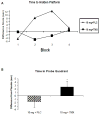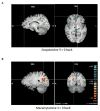Estrogen-cholinergic interactions: Implications for cognitive aging
- PMID: 26187712
- PMCID: PMC4573353
- DOI: 10.1016/j.yhbeh.2015.06.022
Estrogen-cholinergic interactions: Implications for cognitive aging
Abstract
This article is part of a Special Issue "Estradiol and Cognition". While many studies in humans have investigated the effects of estrogen and hormone therapy on cognition, potential neurobiological correlates of these effects have been less well studied. An important site of action for estrogen in the brain is the cholinergic system. Several decades of research support the critical role of CNS cholinergic systems in cognition in humans, particularly in learning and memory formation and attention. In humans, the cholinergic system has been implicated in many aspects of cognition including the partitioning of attentional resources, working memory, inhibition of irrelevant information, and improved performance on effort-demanding tasks. Studies support the hypothesis that estradiol helps to maintain aspects of attention and verbal and visual memory. Such cognitive domains are exactly those modulated by cholinergic systems and extensive basic and preclinical work over the past several decades has clearly shown that basal forebrain cholinergic systems are dependent on estradiol support for adequate functioning. This paper will review recent human studies from our laboratories and others that have extended preclinical research examining estrogen-cholinergic interactions to humans. Studies examined include estradiol and cholinergic antagonist reversal studies in normal older women, examinations of the neural representations of estrogen-cholinergic interactions using functional brain imaging, and studies of the ability of selective estrogen receptor modulators such as tamoxifen to interact with cholinergic-mediated cognitive performance. We also discuss the implications of these studies for the underlying hypotheses of cholinergic-estrogen interactions and cognitive aging, and indications for prophylactic and therapeutic potential that may exploit these effects.
Keywords: Acetylcholine; Attention; Brain imaging; Cognitive performance; Estradiol; Memory.
Published by Elsevier Inc.
Figures








Similar articles
-
Estradiol treatment and its interaction with the cholinergic system: effects on cognitive function in healthy young women.Horm Behav. 2008 Nov;54(5):684-93. doi: 10.1016/j.yhbeh.2008.07.007. Epub 2008 Jul 29. Horm Behav. 2008. PMID: 18706905 Clinical Trial.
-
Understanding the cognitive impact of the contraceptive estrogen Ethinyl Estradiol: tonic and cyclic administration impairs memory, and performance correlates with basal forebrain cholinergic system integrity.Psychoneuroendocrinology. 2015 Apr;54:1-13. doi: 10.1016/j.psyneuen.2015.01.002. Epub 2015 Jan 12. Psychoneuroendocrinology. 2015. PMID: 25679306 Free PMC article.
-
Dopaminergic and cholinergic modulations of visual-spatial attention and working memory: insights from molecular genetic research and implications for adult cognitive development.Dev Psychol. 2012 May;48(3):875-89. doi: 10.1037/a0026198. Epub 2011 Nov 21. Dev Psychol. 2012. PMID: 22103306 Review.
-
Estradiol treatment in young postmenopausal women with self-reported cognitive complaints: Effects on cholinergic-mediated cognitive performance.Hum Psychopharmacol. 2022 Sep;37(5):e2838. doi: 10.1002/hup.2838. Epub 2022 Feb 24. Hum Psychopharmacol. 2022. PMID: 35212023 Free PMC article. Clinical Trial.
-
GPR30 is positioned to mediate estrogen effects on basal forebrain cholinergic neurons and cognitive performance.Brain Res. 2011 Mar 16;1379:53-60. doi: 10.1016/j.brainres.2010.11.098. Epub 2010 Dec 5. Brain Res. 2011. PMID: 21138734 Free PMC article. Review.
Cited by
-
Choline kinase alpha genotype is related to hippocampal brain volume and cognition in postmenopausal women.Heliyon. 2023 Dec 22;10(1):e23963. doi: 10.1016/j.heliyon.2023.e23963. eCollection 2024 Jan 15. Heliyon. 2023. PMID: 38226229 Free PMC article.
-
Electrophysiological and Behavioral Indices of the Role of Estrogens on Memory Processes for Emotional Faces in Healthy Young Women.Front Behav Neurosci. 2019 Oct 1;13:234. doi: 10.3389/fnbeh.2019.00234. eCollection 2019. Front Behav Neurosci. 2019. PMID: 31632252 Free PMC article.
-
Associations of endogenous estrogens, plasma Alzheimer's disease biomarkers, and APOE4 carrier status on regional brain volumes in postmenopausal women.Front Aging Neurosci. 2024 Jul 9;16:1426070. doi: 10.3389/fnagi.2024.1426070. eCollection 2024. Front Aging Neurosci. 2024. PMID: 39044806 Free PMC article.
-
Estrogens, Aging, and Working Memory.Curr Psychiatry Rep. 2018 Oct 11;20(12):109. doi: 10.1007/s11920-018-0972-1. Curr Psychiatry Rep. 2018. PMID: 30306352 Free PMC article. Review.
-
Estrogen, Stress, and Depression: Cognitive and Biological Interactions.Annu Rev Clin Psychol. 2019 May 7;15:399-423. doi: 10.1146/annurev-clinpsy-050718-095557. Epub 2019 Feb 20. Annu Rev Clin Psychol. 2019. PMID: 30786242 Free PMC article. Review.
References
-
- Ábrahám IM, Kőszegi Z, Tolod-Kemp E, Szegő ÉM. Action of estrogen on survival of basal forebrain cholinergic neurons: promoting amelioration. Psychoneuroendocrinology. 2009;34:S104–S112. - PubMed
-
- Albert MS, DeKosky ST, Dickson D, Dubois B, Feldman HH, Fox NC, Gamst A, Holtzman DM, Jagust WJ, Petersen RC, Snyder PJ, Carrillo MC, Thies B, Phelps CH. The diagnosis of mild cognitive impairment due to Alzheimer’s disease: Recommendations from the National Institute on Aging-Alzheimer’s Association workgroups on diagnostic guidelines for Alzheimer’s disease. Alzheimer’s and Dementia. 2011;7:270–279. - PMC - PubMed
-
- Alhola P, Polo-Kantola P, Erkkola R, Portin R. Estrogen therapy and cognition: A 6-year single-blind follow-up study in postmenopausal women. Neurology. 2007;67:706–709. - PubMed
-
- Almeida OP, Lautenschlager NT, Vasikaran S, Leedman P, Gelavis A, Flicker L. A 20-week randomized controlled trial of estradiol replacement therapy for women aged 70 years and older: effect on mood, cognition, and quality of life. Neurobiology of Aging. 2006;27:141–149. - PubMed
Publication types
MeSH terms
Substances
Grants and funding
LinkOut - more resources
Full Text Sources
Other Literature Sources
Miscellaneous

